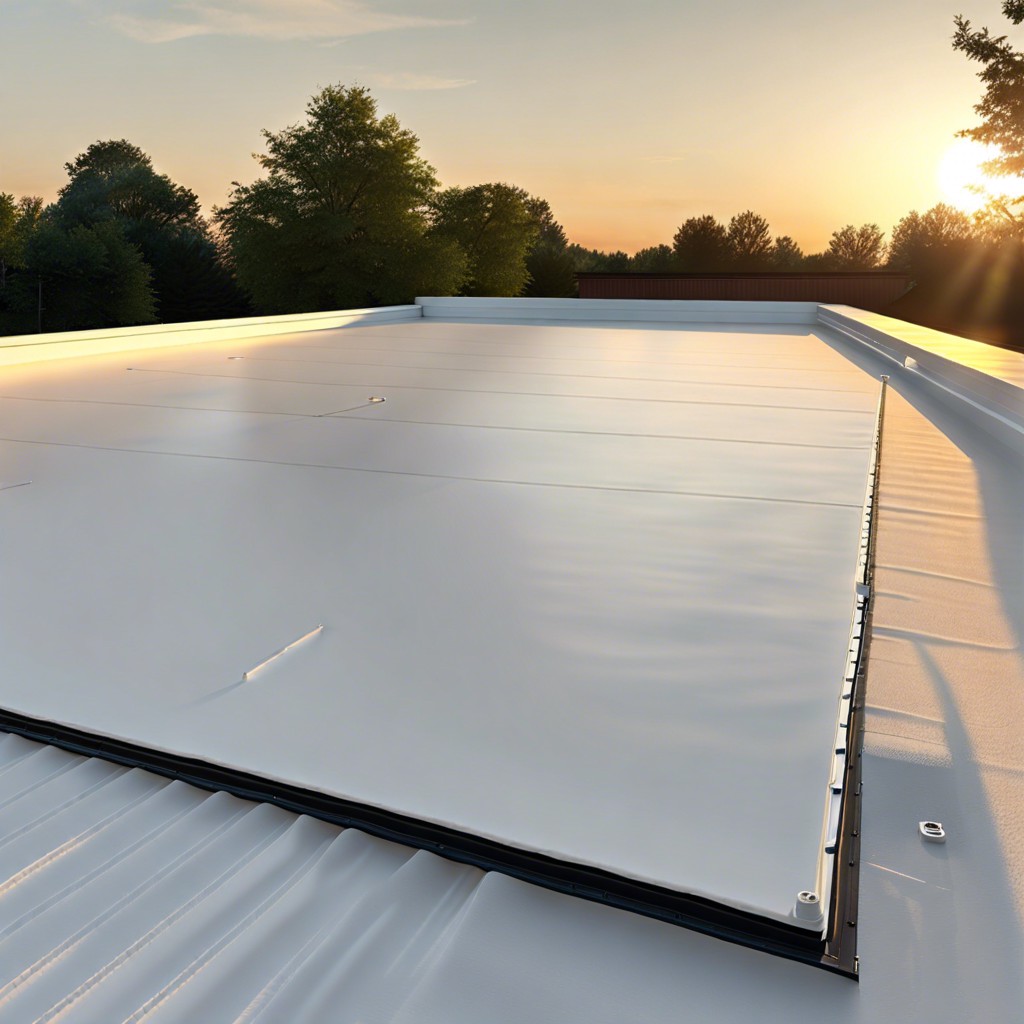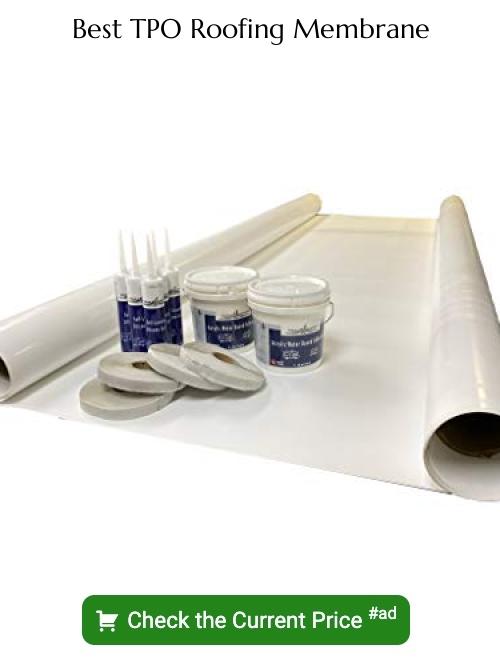Last updated on
Unravel the intricacies of Thermoplastic Olefin (TPO) roofing material as we delve deeper into its features, benefits, and applications in the world of roofing.
Key takeaways:
- TPO roofing has two types: reinforced and non-reinforced.
- Proper installation is crucial for TPO roofing’s longevity and performance.
- TPO roofing is energy efficient and durable, but its lifespan can be shorter.
- TPO roofing costs range from .50 to .50 per square foot installed.
- Consider factors like membrane thickness, energy efficiency, and manufacturer reputation when choosing a TPO roof.
TPO Roofing Materials and Types

Thermoplastic polyolefin (TPO) is a single-ply roofing membrane known for its heat-reflective properties and resistance to ultraviolet (UV) light. Commonly white, it’s available in several thicknesses, typically ranging from 45 to 80 mils, to suit various durability needs.
Two types of TPO roofing systems exist: reinforced and non-reinforced. Reinforced TPO includes a layer of polyester fabric to enhance strength and stability, while non-reinforced TPO is more pliable, often used for direct contact with roof deck surfaces.
Both types can be attached in different ways: mechanically fastened to the roof deck, fully adhered with adhesive, or ballasted with the weight of stone. These installation options offer versatility for different building needs and conditions.
Additionally, TPO membranes can accommodate a variety of insulation materials beneath them, which allows for tailored thermal performance.
TPO Roofing Installation
Proper installation is critical to ensure the longevity and performance of TPO roofing systems. Below are key points that outline the installation process:
- Surface Preparation: Clean and remove all debris from the roof deck to create a smooth substrate. Any moisture, dust, or particles can compromise the adhesion of the TPO membrane.
- Insulation Attachment: Layer insulation boards on the roof deck for energy efficiency. These are either mechanically fastened, adhered with adhesive, or laid under a weighted system depending on roof design.
- Membrane Layout: Roll out the TPO sheets, allowing them to relax and flatten to eliminate wrinkles. Overlap edges to ensure a watertight seal at the seams.
- Seaming: Hot-air weld the seams between sheets with an automatic or hand-held heat gun. This fuses the material together to create a continuous waterproof barrier.
- Flashing Installation: Apply TPO flashing to areas prone to leaks like vents, drain openings, and HVAC units. The flashing must be securely welded to the membrane.
- Detail Work: Address corners, edges, and other unique roof features with precision, ensuring these areas are well-sealed and reinforced.
- Final Inspection: Check the entire roofing system for any defects or weak points in the welded seams.
Adherence to manufacturer’s guidelines and employing skilled installers are essential for a successful TPO roof installation.
Advantages and Disadvantages of TPO Roofing
TPO roofing, recognized for its white reflective surface, offers a range of benefits. A notable advantage is energy efficiency, as it reflects UV rays and helps reduce cooling costs. It’s lightweight, making it easier to install and less burdensome on building structures. Additionally, TPO membranes are resistant to ozone, algae growth, and punctures, enhancing their durability.
On the flip side, one disadvantage is that TPO roofing can have a shorter lifespan compared to traditional materials, with some membranes requiring replacement after 15 to 20 years. The quality of TPO can vary significantly between manufacturers, which means performance can be inconsistent. It should also be noted that installation quality plays a critical role; if not installed by professionals, seams can become weak points prone to leaks and wear.
TPO Roofing Costs
Evaluating the cost of TPO roofing involves several factors, including material prices, installation expenses, and long-term maintenance. Prices can vary widely but generally range from $5.50 to $9.50 per square foot installed.
Factors that influence this cost include:
- Thickness: TPO membranes come in different thicknesses, typically ranging from 45 to 80 mils. Thicker membranes are more durable but also more expensive.
- Insulation: The type and thickness of insulation used under the TPO can affect the overall cost. Insulation improves energy efficiency but adds to the material and labor expenses.
- Size of Roof: Larger roofs may benefit from economies of scale, potentially reducing the cost per square foot as the size of the project increases.
- Labor: Installation costs differ by region and are influenced by the complexity of the roof layout. Features like multiple penetrations or steep slopes can increase labor costs.
- Warranty: A longer or more comprehensive warranty can add to the cost, but it provides greater long-term value by ensuring the roof’s performance over time.
Remember that investing in quality installation and proper maintenance can lead to longer-lasting performance, ultimately saving money on potential repairs or early replacements.
How to Choose a TPO Roof
Selecting the right TPO roof involves understanding your specific needs and the product’s performance characteristics. Consider these factors:
- Membrane Thickness: Generally, thicker membranes offer greater durability and longevity. Standard thickness ranges from 45 to 80 mils.
- Energy Efficiency: Look for high reflective ratings if energy savings is a priority. Lighter colored TPO membranes typically have better reflectivity.
- Manufacturer Reputation: Opt for products from reputable manufacturers with a track record of performance and robust warranties.
- Installation Expertise: Ensure your contractor has experience with TPO installation, as proper fitting is crucial for long-term performance.
- Code Compliance: Verify that the TPO roofing material meets or exceeds local building codes and standards for wind uplift, fire resistance, and other relevant criteria.
- Roofing Accessories: Match your TPO membrane with compatible accessories such as adhesives, flashings, and insulation to guarantee a cohesive roofing system.
- Cost vs. Performance: Balance your budget with the desired performance features. Investing more upfront in a high-quality TPO roof could yield long-term savings on maintenance and energy costs.
Taking these considerations into account will ensure you select a TPO roofing system that meets your building’s needs and provides long-lasting protection.
FAQ
Is TPO roofing expensive?
The cost of TPO roofing typically ranges from $3.50 to $14.00 per square foot, reflecting the wide variation in thickness options available.
Is TPO better than EPDM?
While both TPO and EPDM are reliable roofing options, EPDM tends to be more durable and thereby offers a longer lifespan.
What is the average lifespan of TPO roofing?
The average lifespan of TPO roofing is approximately 15-20 years.
How does TPO roofing fare in extreme weather conditions?
TPO roofing demonstrates excellent performance in extreme weather conditions due to its resistance against UV rays, flexibility in cold temperatures, and durability against high winds and heavy rainfall.
What are the main advantages and disadvantages of TPO roofing versus traditional materials?
TPO roofing offers superior energy efficiency and durability compared to traditional materials, but its longevity might be questionable under certain weather conditions, and it can be prone to punctures and leaks due to its single-ply nature.





